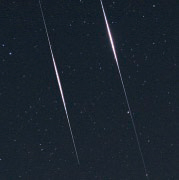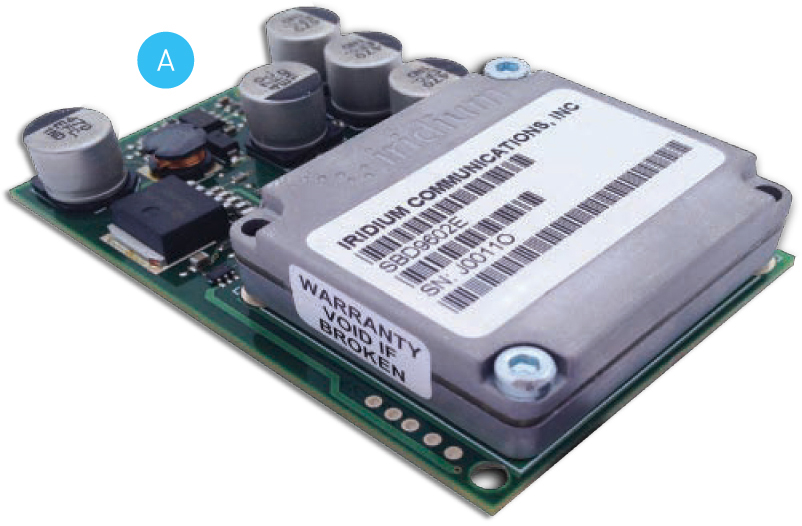Worldwide Satellite Signaling
Calling Out Around the World
Use the Iridium satellite network to communicate with your projects anywhere they can see the sky.
MODERATE
Time Required: 1–2 Hours Cost: $300–$400
Link three boards to build a global tracking beacon.
Materials
» RockBlock satellite modem Available in noncommercial, commercial, bare-board, and waterproof ruggedized forms from Rock Seven Mobile Services, rock7mobile.com
» Arduino Nano or compatible 5V microcontroller
» GPS module such as Adafruit Ultimate GPS Breakout, Maker Shed #MKAD57, makershed.com
» USB cable to fit your microcontroller
» Breadboard (optional)
» USB external battery pack (optional)
Tools
» Computer PC, Mac, or Linux. Laptop preferred.
If you’re old enough to remember the pre-cellphone era, you’ve probably already heard of Iridium (the company, not the chemical element). Deployment of the Iridium satellite constellation began in the early 1990s and, by the time the company launched its globe-spanning consumer satellite phone service in late 1998, had cost an estimated $5 billion.
It was a disaster. Phones were expensive, bulky, and unreliable compared to ground-based cell services. Iridium LLC filed for Chapter 11 bankruptcy less than a year later and, in 2001, the satellite constellation and other assets were sold off for a scant $25 million. At one point, there was serious talk of deorbiting the entire fleet of satellites to prevent them becoming hazardous space junk.
Given all that, you may be surprised to hear that the Iridium network is still up and running. You may be even more surprised to hear that plans are underway to launch a second-generation Iridium constellation, starting in 2015, called Iridium NEXT. And whatever the fate of that venture may be, the original satellites are expected to remain in service until the 2020s.
Makers Take Over
Though the U.S. Department of Defense remains a major user of the Iridium network, the big fizzle of the company’s original world-spanning private satphone service has resulted in a surplus of unused bandwidth spinning, quite literally, right over our heads. It’s a buyer’s market, and the tech to access it is now trickling down to hobbyists and entrepreneurs.
British developer Rock Seven Mobile, for instance, recently introduced an Arduino-compatible Iridium satellite transceiver called RockBlock (Figure A). It can’t make real-time voice phone calls, but it can send “text messages” using Iridium’s short burst data (SBD) service. Outgoing messages of up to 340 bytes can be directed to an email address or a web server as an HTTP post. Incoming messages are limited to 270 bytes and can be received through the same channels.
The RockBlock Naked Iridium modem costs about $250 (plus small monthly access and data charges) and lets you communicate with your project, through the web, anywhere on the surface of the planet you can get 100mA at 5V DC.
RockBlock modems are being installed in high-altitude balloons, free-drifting ocean buoys, autonomous boats, and fixed-wing drone gliders, just to name a few. Connected to a low-cost GPS module, an AVR microcontroller, and a power source, the RockBlock becomes a global tracking device. As long as the power supply holds out and the antennae can see the sky, you can track this stack of circuit boards anywhere it goes, anywhere in the world, from anywhere you can access the web.
Getting Started
Follow the bundled instructions to set up your RockBlock account, then connect the modem to your Arduino, and your Arduino to your GPS module, as shown in Figure B. Visit makezine. com/iridium, download the sketch GlobalBeacon. ino and the necessary libraries, plug in your Arduino, and upload the code.
Each RockBlock ships with a 10-pin JST-terminated cable that snaps onto the board and exposes the various signal lines client devices can connect to. The simplest setup, shown here, is what Iridium calls a “3-wire” TTL serial interface, with signal lines for TX, RX, and Sleep. (To connect your Arduino and GPS as shown, see page 59.)
Gunther Kirsch
You’ll probably need to take everything outside to get a GPS fix and an Iridium link. Open the Arduino IDE’s Serial Monitor window at 115,200 baud and follow along as the code first establishes a GPS fix, then uploads it to the Iridium network, then puts the hardware into low-power “sleep” mode. Left alone, it will “wake up” every hour and repeat this process. Log on to the Rock Seven web portal to read the received messages and set up message handlers.
Going Further
This is just a simple proof-of-concept system powered by the USB connection. The first step toward a real-world application would likely be untethering it from your computer, perhaps with an off-the-shelf USB external battery pack or solar charger.
Don’t forget that the RockBlock can both send and receive messages, opening up a world of possibilities beyond basic tracking and monitoring apps. Want a robot that travels to some remote location, reports back on conditions there, and waits for instructions on how to proceed? This technology makes it not just possible to do that, but relatively cheap and easy. The sky — quite literally — is the only limit. ![]()
Get the sketches and steps to start sending satellite messages at makezine.com/iridiumsatellite Share it: #iridiumsatellite



